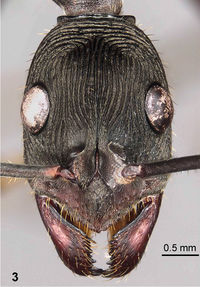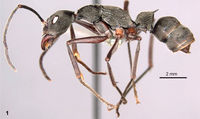Diacamma magdalenae
| Diacamma magdalenae | |
|---|---|

| |
| Scientific classification | |
| Kingdom: | Animalia |
| Phylum: | Arthropoda |
| Class: | Insecta |
| Order: | Hymenoptera |
| Family: | Formicidae |
| Subfamily: | Ponerinae |
| Tribe: | Ponerini |
| Genus: | Diacamma |
| Species: | D. magdalenae |
| Binomial name | |
| Diacamma magdalenae Laciny, Pal & Zettel, 2015 | |
Specimens have been collected from forest habitats.
| At a Glance | • Gamergate |
Identification
Laciny et al. (2015) - Moderately large, slender species (TL 12.72–14.80 mm). Trunk black; mandibles and legs dark reddish brown. Standing setae relatively short; fine pilosity either absent or inconspicuous on head, mesosoma, and petiole. Trunk strongly striate from genae to gaster tergite 1. Head elongated, sides posteriorly of eye strongly convex. Striation posterior of eyes parted, forming a pair of loops, most posterior striae concentrically bowed, by that only the outer one reaching the broad occipital margin which ventrally terminates in short, blunt teeth. Eyes moderately large, protruding. Clypeus strongly convex, with very fine microsculpture, basally with additional fine striation; apex forming a distinct, obtuse angle. Mandible with obliterate fine striation. Striae on pronotum transverse at centre, around them forming an almost squared structure. Striation on mesosoma sides slightly oblique. Petiole distinctly compressed, its teeth relatively long and narrow; subpetiolar process prominent, concave, posterior corner strongly developed. Gaster tergite 1 with semi-elliptical striation; tergites 2–3 (and 4 if visible) with transverse stripes of longitudinal striae. Within the examined samples of D. magdalenae we observed considerable variability in eye index and spine distance index.
Diacamma magdalenae belongs to a group of species around Diacamma intricatum and Diacamma holosericum that is defined by a distinctly compressed petiole and a very peculiar head structure: The coarse rugae form concentric bows posteriorly and only the outer one reaches the strongly developed occipital carina. Examined specimens of Diacamma intricatum and Diacamma holosericum show a strong variability in size and structural details; therefore we speculate that both are complexes of several species distributed on Borneo, Sumatra, Java, and some smaller adjacent islands.
Diacamma magdalenae is outstanding by possessing a coarse striation on gaster tergites 1–3(4). Diacamma holosericum is without striation on the gaster, and in D. intricatum s.l. such striation is usually restricted to gaster tergite 1 where it is variably developed (from faint to coarse). Only in D. intricatum ssp. kershawi, described from northern Borneo, the gaster tergite 2 bears some faint striae, but in contrast to D. magdalenae “the striae on the upper surface of the petiole and first gastric segment [are] almost obliterated”. We have studied a specimen from Sarawak (in NHMW) with similar gaster structures.
Distribution
Borneo: Sarawak, West Kalimantan.
Distribution based on Regional Taxon Lists
Indo-Australian Region: Borneo, Indonesia (type locality), Malaysia (type locality).
Distribution based on AntMaps
Distribution based on AntWeb specimens
Check data from AntWeb
Countries Occupied
| Number of countries occupied by this species based on AntWiki Regional Taxon Lists. In general, fewer countries occupied indicates a narrower range, while more countries indicates a more widespread species. |

|
Estimated Abundance
| Relative abundance based on number of AntMaps records per species (this species within the purple bar). Fewer records (to the left) indicates a less abundant/encountered species while more records (to the right) indicates more abundant/encountered species. |

|
Biology
Castes
Nomenclature
The following information is derived from Barry Bolton's Online Catalogue of the Ants of the World.
- magdalenae. Diacamma magdalenae Laciny, Pal & Zettel, 2015: 86, figs. 1-6 (w.) BORNEO.
Unless otherwise noted the text for the remainder of this section is reported from the publication that includes the original description.
Description
Worker
Holotype: TL 13.43; HW 2.15; HL 3.10; EL 0.72; SL 4.11; PH 1.89; PL 1.37; PW 0.96; SpD 0.69; SpL 0.54; WL 4.70; MTL 3.10. Indices: CI 69; SI 191; PI 72; SpDI 74; SpLI 57; EI 33. Paratypes (n = 10): TL 12.72–14.80; HW 1.97–2.32; HL 2.87–3.26; EL 0.61–0.72; SL 3.72–4.40; PH 1.61–1.96; PL 1.27–1.41; PW 0.89–1.02; SpD 0.55–0.71; SpL 0.45–0.58; WL 4.37–4.92; MTL 2.77–3.29. Indices: CI 69–71; SI 182–197; PI 71–79; SpDI 59–75; SpLI 47–62; EI 26–33.
Structures: Head elongated; sides long and parallel in front of eyes, strongly convex behind eyes. Eyes moderately large, slightly protruding. Very coarse rugae present from genae to gaster tergite 1. Posterior of eyes, rugae parted, forming a pair of loops (rarely asymmetrical, comp.), most posterior striae concentrically bowed, by that only the outer one reaching head margin. Occipital margin broad, slightly wider than one ruga, laminate, ventrally very short, terminating in inconspicuous, blunt teeth in lateral aspect. Clypeus strongly convex at basal half, in some specimens almost obtusely carinate medially, with very fine microsculpture, base with additional fine striation, moderately shiny; sockets of setae forming small but distinct protuberances; apex forming a distinct obtuse angle medially. Mandible with obliterate fine striation. Striae on pronotum transverse at centre, around them forming an almost squared pattern. Striation on mesosoma sides slightly oblique. Posterior face of propodeum separated from sides by distinct carinae. Petiole distinctly compressed, sides with coarse striation parted at dorsal face; spines long and narrow. Subpetiolar process prominent, in lateral aspect concave, with acute to spine-like posterior tooth that is always slightly stronger than anterior one; in ventral aspect narrow, with more or less distinct margins anteriorly and with complete median carina. Gaster tergite 1 with semi-elliptical striation; tergites 2–3 with transverse stripes of longitudinal striae; a similar structure on tergite 4 in three paratypes where this plate is visible at larger extent.
Pilosity: Standing setae on trunk short, only a few on clypeus, underside of head, and abdominal apex longer. Short appressed pilosity of trunk mostly scarce, but dense on clypeus and gaster. Standing setae on scape extremely short, on legs short.
Colour: Trunk black, without metallic shimmer. Clypeus, mandibles and legs dark reddish brown. On gaster posterior margins of tergites and apex more or less orange brown. Antennae black; legs medium to dark reddish brown, but forecoxa and tarsi strongly infuscated.
Type Material
Holotype (worker, Naturhistorisches Museum Wien, Vienna, CASENT0915959), Borneo, Sarawak, Gunung Mulu National Park, N 04° 02' 30”, E 114° 48' 46”, alluvial forest, 13.XI.2009, leg. D. M. Sorger (#82). Paratypes (all from Gunung Mulu National Park): 3 workers (NHMW), same locality data as holotype; 2 workers (CMS; NHMW, CASENT0915960), N 04° 02' 30”, E 114° 52' 15”, dipterocarp forest, 23–26.X.2009, leg. D. M. Sorger (#20); 1 worker (CMS), N 04° 02' 30”, E 114° 48' 46”, alluvial / kerangas / limestone forest, along nightwalk trail, 22.X.2009, leg. D. M. Sorger (#12); 1 worker (CMS), N 04° 02' 30”, E 114° 48' 46”, kerangas / limestone forest, along nightwalk trail, 1 m2 Winkler sampling, 22.X.2009, leg. D. M. Sorger (#14); 1 worker (CMS), N 04° 02' 30”, E 114° 48' 46”, alluvial / kerangas / limestone forest, 11.XI.2009, leg. D. M. Sorger (#74); 1 worker (Herbert and S.V. Zettel), way to camp 5, 13–15.VII.2010, leg. D. M. Sorger (#GM10-H11); 1 worker (Museo Civico di Storia Naturale, Genoa), Borneo, West Kalimantan, Kapuas, “Ban du Kapouas” [exact locality not found], “1896” [? date of acquisition], leg. M. A. Chaper.
Etymology
Kindly dedicated to D. Magdalena Sorger, enthusiastic “antist” who collected this and many other interesting ant species during her adventurous expeditions to Borneo.
References
References based on Global Ant Biodiversity Informatics
- Laciny A., A. Pal, and H. Zettel. 2015. Taxonomic notes on the ant genus Diacamma Mayr, 1862 (Hymenoptera: Formicidae), part 1. Zeitschrift der Arbeitsgemeinschaft Österreichischer Entomologen 67: 83-136.

